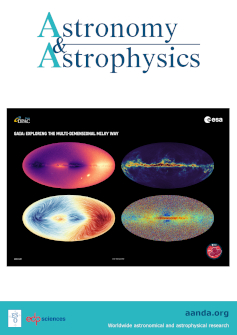The population of young low-mass stars in Trumpler 14⋆⋆⋆
IF 5.4
2区 物理与天体物理
Q1 ASTRONOMY & ASTROPHYSICS
引用次数: 0
Abstract
Massive star-forming regions are thought to be the most common birth environments in the Galaxy and the only birth places of very massive stars. Their presence in the stellar cluster alters the conditions within the cluster, impacting at the same time the evolution of other cluster members. In principle, copious amounts of ultraviolet radiation produced by massive stars can remove material from outer parts of the protoplanetary discs around low- and intermediate-mass stars in the process of external photoevaporation, effectively reducing the planet formation capabilities of those discs. Here, we present deep VLT/MUSE observations of low-mass stars in Trumpler 14, one of the most massive, young, and compact clusters in the Carina Nebula Complex. We provide spectral and stellar properties of 717 sources and based on the distribution of stellar ages, derive the cluster age of ∼1 Myr. The majority of the stars in our sample have masses ≤1 M⊙, which makes our spectroscopic catalogue the deepest to date in term of mass and proves that detailed investigations of low-mass stars are possible in the massive but distant regions. Spectroscopic studies of low-mass members of the whole Carina Nebula Complex are missing. Our work marks an important step forward towards filling this gap and sets the stage for follow-up investigations of accretion properties in Trumpler 14.Trumpler 14⋆⋆⋆中的年轻低质量恒星群
大质量恒星形成区被认为是银河系中最常见的诞生环境,也是大质量恒星的唯一诞生地。它们在恒星簇中的存在会改变簇内的条件,同时影响簇内其他成员的演化。原则上,大质量恒星产生的大量紫外线辐射会在外部光蒸发过程中带走中低质量恒星周围原行星盘外部的物质,从而有效降低这些行星盘的行星形成能力。在这里,我们展示了VLT/MUSE对Trumpler 14中低质量恒星的深度观测,Trumpler 14是船底座星云群中质量最大、最年轻、最紧凑的星团之一。我们提供了717个星源的光谱和恒星特性,并根据恒星年龄的分布推算出星团的年龄为1 Myr∼。在我们的样本中,大多数恒星的质量≤1 M⊙,这使得我们的光谱目录成为迄今为止质量最深的目录,并证明了在大质量但遥远的区域对低质量恒星进行详细研究是可能的。对整个船底座星云群中低质量恒星的光谱研究是空白。我们的工作标志着在填补这一空白方面迈出了重要的一步,并为后续调查Trumpler 14的吸积特性奠定了基础。
本文章由计算机程序翻译,如有差异,请以英文原文为准。
求助全文
约1分钟内获得全文
求助全文
来源期刊

Astronomy & Astrophysics
地学天文-天文与天体物理
CiteScore
10.20
自引率
27.70%
发文量
2105
审稿时长
1-2 weeks
期刊介绍:
Astronomy & Astrophysics is an international Journal that publishes papers on all aspects of astronomy and astrophysics (theoretical, observational, and instrumental) independently of the techniques used to obtain the results.
 求助内容:
求助内容: 应助结果提醒方式:
应助结果提醒方式:


